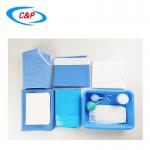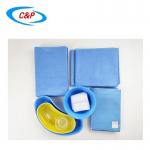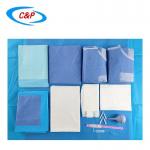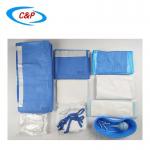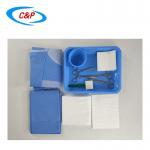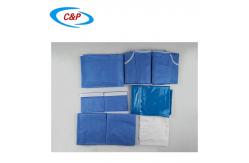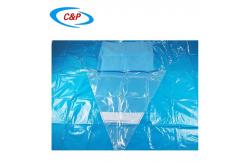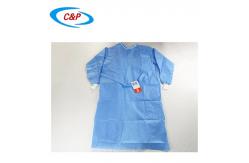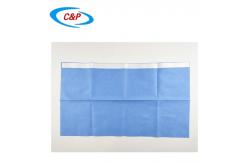Product Description:
Baby delivery kit, also known as an obstetric pack or childbirth
set, is a collection of sterile medical supplies and equipment used
during the delivery of a baby. It is typically prepared and used in
hospitals, clinics, or birthing centers to ensure a clean and safe
delivery environment.
Baby delivery kit is a sterile package used during childbirth or
cesarean section procedures to maintain an aseptic environment and
provide a barrier against contamination. It typically contains a
combination of drapes, towels, and other accessories necessary for
the procedure. The specific contents may vary depending on the
manufacturer and the requirements of the healthcare facility.
Technical Parameters:
| Product Category | Baby Delivery Kit |
| Sample | Freight Collected |
| Material | SMS, PP, PE, Spunlace Non-woven Fabric |
| Application | Hospital And Clinic |
| Certificate | CE&ISO13485 |
| Efficiency | Allows for quick and efficient setup before a procedure |
| Feature | Soft, Procedure, Convenient, Waterproof |
| Sterility | Individually packaged in sterile bags |
| Infection Control | Key component of standard infection control practices |
| Detail | 2pcs surgical gown L 130x150cm 2pcs leggings 80x120cm 1pc non-sip field with collection pouch 150x150cm 1pc table cover 150x180cm 1pc surgical drape 150x180cm 2pcs hand towel 30x40cm 2pcs non-slip drape 40x60cm |
Pictures:
Features:
Baby delivery kit typically consists of a set of medical drapes and
other accessories used during surgical procedures, specifically for
delivering babies via cesarean section or vaginal delivery. The
features of a baby delivery kit may vary depending on the specific
pack and the manufacturer, but here are some common features:
1. Sterility: Baby delivery kits are sterile to maintain a clean
and safe surgical environment, reducing the risk of infections.
2. Drape Materials: The drapes are typically made of non-woven,
low-linting, and fluid-resistant materials such as polypropylene or
polyethylene, ensuring a barrier against fluid and microorganisms.
3. Absorbency: The drapes may have absorbent properties to manage
and contain fluids during the delivery process.
4. Fenestrations: The drapes have strategically placed
fenestrations (openings) to allow access to the specific surgical
site while maintaining the surrounding area covered and protected.
5. Adhesive or Incise Film: Some drapes may have an adhesive
backing or an incise film to secure them in place and provide a
sterile surface for incisions.
6. Tubes and Pouches: Baby delivery kits may include integrated
pouches or tubes to collect and channel fluids away from the
surgical site.
7. Velcro Straps or Ties: The drapes may feature Velcro straps or
ties to secure them around the patient and ensure a snug fit.
8. Compatibility: Baby delivery kits are designed to be compatible
with various surgical tables and setups, allowing for easy
integration into the surgical workflow.
9. Packaging: The baby delivery kit comes in a sterile, sealed
packaging to maintain the sterility of the contents until opened
for use.
These features work together to create a safe and sanitary
environment for childbirth while also considering the needs and
comfort of the mother and baby.
Applications:
The application of a baby delivery kit is an essential procedure in
ensuring a sterile environment during childbirth, especially in
hospital settings. Here's a step-by-step guide to its application:
1. Preparation: Before the birth begins, the healthcare provider
should ensure that all necessary materials are available and easily
accessible. This includes the baby delivery kit, sterile gloves,
and any other required instruments or materials.
2. Opening the baby delivery kit: The healthcare provider should
open the baby delivery kit using aseptic technique to maintain
sterility. This involves carefully opening the package without
touching the inner contents with non-sterile hands or surfaces.
3. Applying the Waterproof Pad: Begin by placing the waterproof pad
or sheet on the bed or delivery table to protect the surface and
provide a layer of comfort for the mother.
4. Positioning the Mother: Help the mother into a comfortable
position, usually lying on her back with her knees bent and spread
apart. Privacy and comfort should be maintained throughout the
process.
5. Drape Application: Take the drapes out of the baby delivery kit
and use them to create a makeshift "tent" around the perineal area.
This enclosure helps to maintain privacy and keeps the area
sterile. The drapes should be positioned in such a way that they do
not interfere with the birth process but effectively isolate the
perineal area.
6. Sterile Gloves and Towels: Put on sterile gloves and use sterile
towels or wipes to clean and prepare the perineal area before the
birth.
7. Instruments and Lubricant: Have sterile instruments, such as
scissors and clamps, ready for use if needed (for cutting and
clamping the umbilical cord, for example). Also, ensure that
sterile lubricant is available if required to assist in the
delivery process.
8. During Delivery: During the actual birth, the healthcare
provider should maintain the sterile field by avoiding
contamination from non-sterile areas. This might involve adjusting
the drapes slightly to accommodate the progress of labor without
compromising sterility.
9. After Delivery: After the baby is born, the placenta and
membranes will be delivered next. The healthcare provider will use
the sterile instruments from the baby delivery kit to manage the
umbilical cord and placenta, ensuring safe delivery and proper
disposal of these materials.
10. Cleanup and Disposal: Once the delivery is complete and the
placenta is expelled, the used drapes, pads, and other materials
should be carefully and safely disposed of according to hospital
policy. Cleanup should be done while maintaining a sterile
environment for any further procedures, like stitches for tears or
episiotomies.
11. Postpartum Care: The baby delivery kit may also include
materials for immediate postpartum care, such as sanitary pads or
underwear for the mother. Ensure that the mother is comfortable and
has everything she needs for initial recovery.
The application of a baby delivery kit is a critical step in
ensuring a successful and safe childbirth in a controlled medical
setting. The steps above outline how to use it effectively to
maintain a sterile and respectful environment for the birthing
mother.
Customization:
Customized service for baby delivery kits allows healthcare
providers and facilities to tailor these packs to their specific
needs and preferences. Here are some ways in which customization
can be applied to baby delivery kits:
1. Size Customization: Depending on the size of the delivery area,
you can request a customized baby delivery kit that fits your
specific needs. This ensures that the drape is not too small or too
large, providing an optimal fit and coverage.
2. Color Customization: Some hospitals or medical facilities may
require the use of colored disposable delivery kits for
identification purposes or to match with their existing color
schemes. You can specify the color of the packs in your order.
3. Material Customization: The material used for the baby delivery
kits can be customized based on the preferences of the healthcare
provider or facility. For example, some may prefer a more absorbent
material for better fluid management, while others might prefer a
thicker or thinner material for different levels of protection.
4. Design Customization: In some cases, healthcare providers
may have specific design requirements for their baby delivery kits,
such as including logos, symbols, or text. These custom designs can
be incorporated into the baby delivery kits to enhance branding or
provide additional information.
5. Packaging Customization: The packaging of the baby delivery
drape kit can also be customized to meet specific needs. This
includes the type of packaging material (e.g., plastic, paper), the
size of the packaging, and any additional features like labels or
instructions.
6. Bulk Orders: If you are ordering a large quantity of
disposable baby delivery kits, you may have the option to customize
the packaging to accommodate the volume and ensure efficient
handling and storage.
7. Special Needs: In some cases, healthcare providers may need
specialized disposable baby delivery kits for patients with
specific conditions or allergies. These could include
hypoallergenic materials, antimicrobial properties, or other unique
features tailored to the patient's needs.
By offering customized services, baby delivery kit manufacturers
can cater to the unique requirements of various healthcare
facilities and providers, ensuring that they receive the best
possible product for their specific needs.
Packing and Shipping:
Product Packaging:
The baby delivery kit is packaged in a sterile, sealed plastic bag
to ensure cleanliness and safety. The bag is labeled with the
product name, lot number, and expiration date.
Shipping:
The baby delivery kit is shipped in a sturdy cardboard box to
prevent damage during transportation. The box is labeled with the
product name, quantity, and shipping address.
